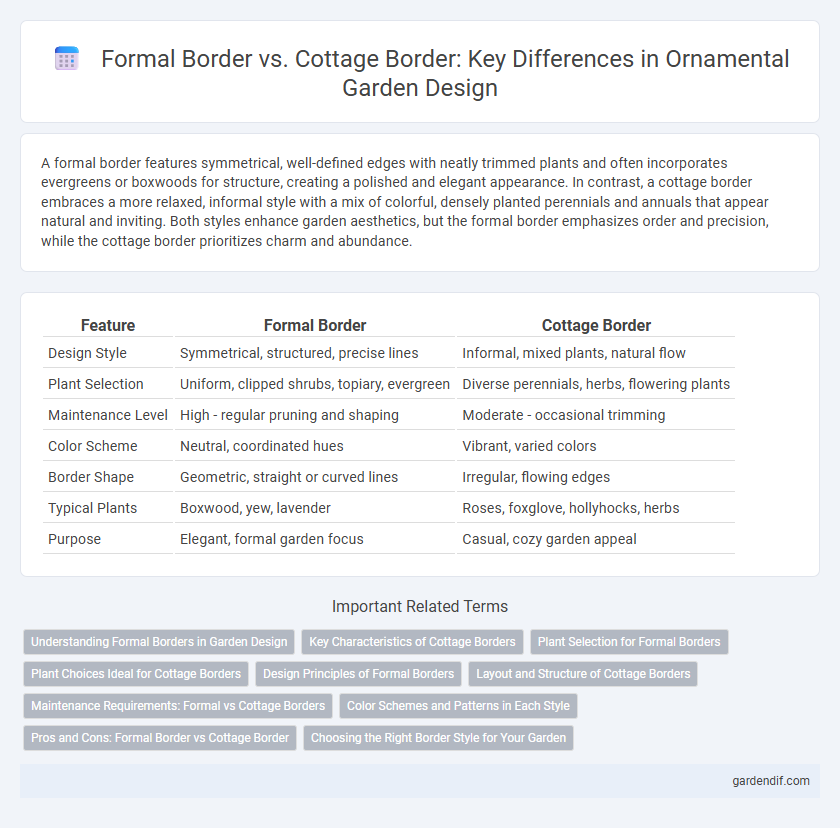
Formal Border vs Cottage Border Illustration
A formal border features symmetrical, well-defined edges with neatly trimmed plants and often incorporates evergreens or boxwoods for structure, creating a polished and elegant appearance. In contrast, a cottage border embraces a more relaxed, informal style with a mix of colorful, densely planted perennials and annuals that appear natural and inviting. Both styles enhance garden aesthetics, but the formal border emphasizes order and precision, while the cottage border prioritizes charm and abundance.
Table of Comparison
| Feature | Formal Border | Cottage Border |
|---|---|---|
| Design Style | Symmetrical, structured, precise lines | Informal, mixed plants, natural flow |
| Plant Selection | Uniform, clipped shrubs, topiary, evergreen | Diverse perennials, herbs, flowering plants |
| Maintenance Level | High - regular pruning and shaping | Moderate - occasional trimming |
| Color Scheme | Neutral, coordinated hues | Vibrant, varied colors |
| Border Shape | Geometric, straight or curved lines | Irregular, flowing edges |
| Typical Plants | Boxwood, yew, lavender | Roses, foxglove, hollyhocks, herbs |
| Purpose | Elegant, formal garden focus | Casual, cozy garden appeal |
Understanding Formal Borders in Garden Design
Formal borders in garden design emphasize symmetry, precise geometric shapes, and neatly trimmed plants that create a structured, elegant appearance. These borders often use evergreen shrubs, boxwoods, and uniform flower beds to maintain a consistent and orderly look throughout the seasons. Understanding formal borders involves recognizing their role in defining spaces and framing pathways with clarity and sophistication.
Key Characteristics of Cottage Borders
Cottage borders feature a relaxed, informal arrangement with a diverse mix of flowering plants, herbs, and foliage, creating a natural, charming look. Their key characteristics include dense planting, a blend of colors and textures, and a layered structure that encourages continuous bloom throughout the growing season. Unlike formal borders, cottage borders emphasize spontaneity and a harmonious, wild garden aesthetic.
Plant Selection for Formal Borders
Formal borders emphasize symmetrical plant selection with evergreen shrubs such as boxwood (Buxus sempervirens) and yew (Taxus baccata), providing year-round structure and clean lines. Plants are typically clipped into geometric shapes to maintain a uniform appearance, often incorporating seasonal flowering plants like tulips or lavender for color contrast. This method contrasts with the informal mix of perennials and annuals found in cottage borders, prioritizing precision and order over plant diversity.
Plant Choices Ideal for Cottage Borders
Cottage borders favor a diverse mix of informal, perennial plants such as foxgloves, lupines, hollyhocks, and delphiniums that create a relaxed, natural look with vibrant colors and varied textures. Unlike the structured, symmetrical plantings typical of formal borders, cottage borders thrive on heirloom varieties and native wildflowers that attract pollinators and enhance biodiversity. Selecting plants with staggered bloom times ensures continuous visual interest and supports a dynamic, evolving garden ecosystem.
Design Principles of Formal Borders
Formal borders in garden design emphasize symmetry, clean lines, and geometric shapes, creating a structured and balanced aesthetic. Plant choices typically include low-growing, neatly trimmed shrubs and repetitive patterns to reinforce order and precision. This style contrasts with cottage borders that favor informal layouts, diverse plant heights, and a more natural, eclectic appearance.
Layout and Structure of Cottage Borders
Cottage borders feature an informal, dense, and layered layout that creates a lush, overflowing appearance with mixed heights and textures. Their structure emphasizes a relaxed, natural arrangement often including climbing plants, perennials, and herbs interspersed with annuals for continuous interest. This organic, asymmetrical design contrasts sharply with the tidy, geometric organization typical of formal borders.
Maintenance Requirements: Formal vs Cottage Borders
Formal borders require precise, regular maintenance including frequent trimming, weeding, and pruning to uphold their symmetrical design and clean lines. Cottage borders are more forgiving, allowing for natural growth and intermittent upkeep such as occasional deadheading and selective pruning to maintain a relaxed, informal appearance. The maintenance intensity of formal borders demands consistent attention, while cottage borders thrive with more flexible, low-maintenance care.
Color Schemes and Patterns in Each Style
Formal borders feature symmetrical patterns with structured plant arrangements, often incorporating repetitive color schemes such as monochromatic shades or contrasting colors like deep greens paired with bright reds or whites to emphasize order and elegance. Cottage borders embrace a more informal, eclectic mix of colors, blending soft pastels with vibrant hues in a seemingly random yet harmonious pattern that creates a natural, romantic charm. The use of uniform height and tightly packed plants in formal borders contrasts with the varied heights and loosely spaced flowers typical of cottage borders, contributing to their distinct visual rhythms.
Pros and Cons: Formal Border vs Cottage Border
A Formal Border offers a structured, symmetrical design with neatly trimmed plants, providing a polished and elegant appearance that requires regular maintenance to retain its shape. In contrast, a Cottage Border embraces a more relaxed and informal layout, featuring a diverse mix of flowering plants that encourage biodiversity but may appear less tidy and demand frequent weeding. Choosing between Formal and Cottage Borders depends on the gardener's preference for orderliness versus natural charm and the level of time available for upkeep.
Choosing the Right Border Style for Your Garden
Formal borders emphasize symmetry and clean lines, often featuring neatly trimmed hedges and uniformly spaced plants that create a structured, elegant look suited for traditional gardens. Cottage borders offer a more relaxed, natural appearance with informal arrangements of colorful flowers and varied foliage, ideal for creating a charming, whimsical garden atmosphere. Selecting between formal and cottage borders depends on your garden's overall design, maintenance preferences, and the desired ambiance, balancing precision with casual beauty.
Formal Border vs Cottage Border Infographic

 gardendif.com
gardendif.com